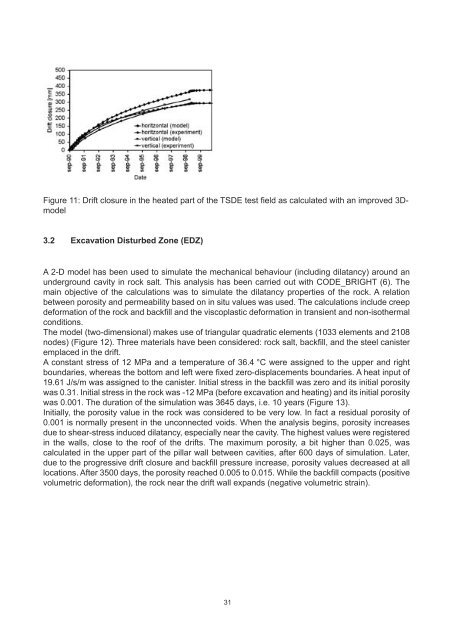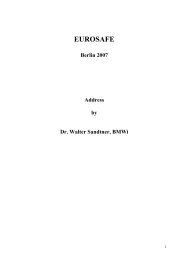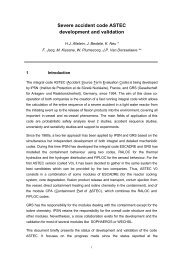Final Results of the BAMBUS II Project - Eurosafe Forum
Final Results of the BAMBUS II Project - Eurosafe Forum
Final Results of the BAMBUS II Project - Eurosafe Forum
You also want an ePaper? Increase the reach of your titles
YUMPU automatically turns print PDFs into web optimized ePapers that Google loves.
Figure 11: Drift closure in <strong>the</strong> heated part <strong>of</strong> <strong>the</strong> TSDE test field as calculated with an improved 3Dmodel<br />
3.2 Excavation Disturbed Zone (EDZ)<br />
A 2-D model has been used to simulate <strong>the</strong> mechanical behaviour (including dilatancy) around an<br />
underground cavity in rock salt. This analysis has been carried out with CODE_BRIGHT (6). The<br />
main objective <strong>of</strong> <strong>the</strong> calculations was to simulate <strong>the</strong> dilatancy properties <strong>of</strong> <strong>the</strong> rock. A relation<br />
between porosity and permeability based on in situ values was used. The calculations include creep<br />
deformation <strong>of</strong> <strong>the</strong> rock and backfill and <strong>the</strong> viscoplastic deformation in transient and non-iso<strong>the</strong>rmal<br />
conditions.<br />
The model (two-dimensional) makes use <strong>of</strong> triangular quadratic elements (1033 elements and 2108<br />
nodes) (Figure 12). Three materials have been considered: rock salt, backfill, and <strong>the</strong> steel canister<br />
emplaced in <strong>the</strong> drift.<br />
A constant stress <strong>of</strong> 12 MPa and a temperature <strong>of</strong> 36.4 °C were assigned to <strong>the</strong> upper and right<br />
boundaries, whereas <strong>the</strong> bottom and left were fixed zero-displacements boundaries. A heat input <strong>of</strong><br />
19.61 J/s/m was assigned to <strong>the</strong> canister. Initial stress in <strong>the</strong> backfill was zero and its initial porosity<br />
was 0.31. Initial stress in <strong>the</strong> rock was -12 MPa (before excavation and heating) and its initial porosity<br />
was 0.001. The duration <strong>of</strong> <strong>the</strong> simulation was 3645 days, i.e. 10 years (Figure 13).<br />
Initially, <strong>the</strong> porosity value in <strong>the</strong> rock was considered to be very low. In fact a residual porosity <strong>of</strong><br />
0.001 is normally present in <strong>the</strong> unconnected voids. When <strong>the</strong> analysis begins, porosity increases<br />
due to shear-stress induced dilatancy, especially near <strong>the</strong> cavity. The highest values were registered<br />
in <strong>the</strong> walls, close to <strong>the</strong> ro<strong>of</strong> <strong>of</strong> <strong>the</strong> drifts. The maximum porosity, a bit higher than 0.025, was<br />
calculated in <strong>the</strong> upper part <strong>of</strong> <strong>the</strong> pillar wall between cavities, after 600 days <strong>of</strong> simulation. Later,<br />
due to <strong>the</strong> progressive drift closure and backfill pressure increase, porosity values decreased at all<br />
locations. After 3500 days, <strong>the</strong> porosity reached 0.005 to 0.015. While <strong>the</strong> backfill compacts (positive<br />
volumetric deformation), <strong>the</strong> rock near <strong>the</strong> drift wall expands (negative volumetric strain).<br />
31





